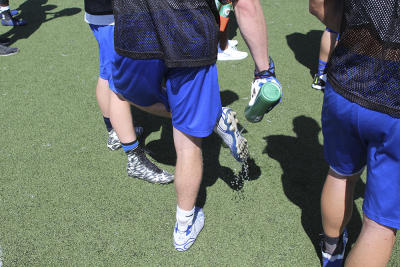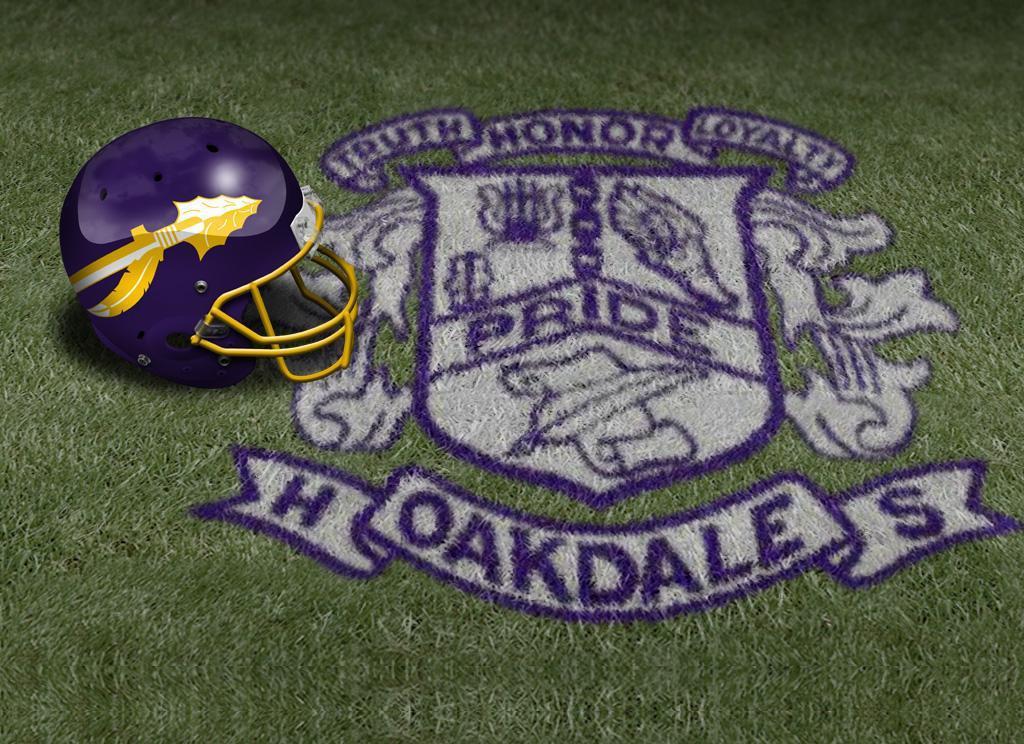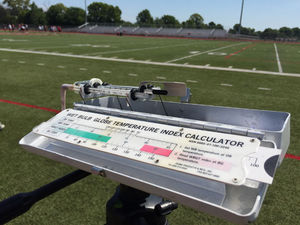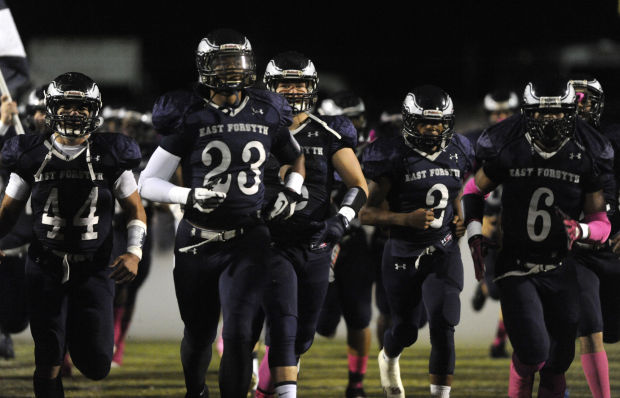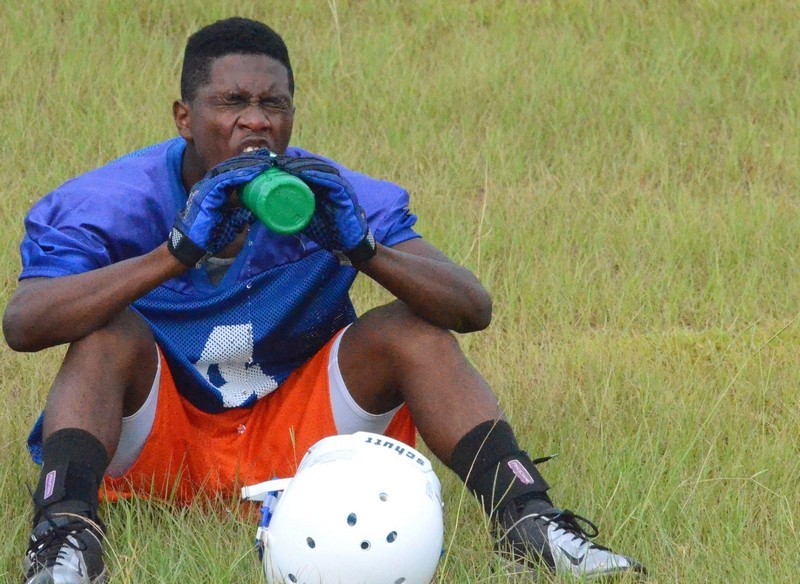
Enloe football coach David Green can remember when his high school coach, who after first reading about Gatorade in Sports Illustrated, came to practice with a homemade concoction that he was sure would help the team’s hydration.
It was Kool-Aid made with salt instead of sugar. After all, the story talked about Gatorade having sodium. The coach was no chemist. “Awful,” Green said. “Nobody wanted it.”
Green also recalled the popular practice of kids taking salt pills and using water only to wash out their mouths.
“I don’t know how they didn’t kill all of us,” he said.
High school football coaches and heat-related hydration practices have come a long way.
Gone are the days that a water break was a reward or motivational carrot to dangle in front of players. Coaches have water available at all times. Players are free to walk over, even during drills, and drink as needed.
“I tell them if you need water, go get it,” Fuquay-Varina coach Jeb Hall said. “If you absolutely have to have it, go get it. Nobody’s going to cuss you out.”
IT’S HARD TO MONITOR THE NEW GUYS, THE NINTH-GRADE KIDS YOU DON’T KNOW.
Fuquay-Varina coach Jeb Hall
Most current high school coaches experienced some kind of water experience akin to the ones Green described in their playing days.
“I don’t know that my coach in high school put water out,” said North Johnston coach Ashley Ennis. “We just went and drank it out of a hose pipe. It was just a different time, but then again we were outside all the time. We worked outside and played outside and we were acclimated to it. We got central heat and air conditioning in 1990.”
Summer heat difficult
Athletic trainers must be present starting from the first day of practice – Aug. 1 – through the rest of the season, but sometimes they are not around during the summer. This puts the onus of player safety on the coaches.
Hall, working with several freshmen and sophomores, cut one summer practice short. He didn’t want to stop the drill but wasn’t familiar with many of the players.
“It’s hard to monitor the new guys, the ninth-grade kids you don’t know,” Hall said. “During the summer when there are no trainers here and it’s on us, it’s tough.”
Hall said he sometimes looks at his most experienced and in-shape players – four-year starter at linebacker Austin Pluckhorn and two-way starting lineman Jonathan Cole – and knows if they’ve got their hands on hips, it’s a good time to take a break.
Green, who said he does have a trainer at his offseason workouts, said he’ll delay practice if it’s too hot outside. Sometimes, he’s started a practice, scheduled for 5 p.m., closer to 7 p.m.
“The parents understand that,” Green said. “I’ve never had one parent complain that we’re going to push practice back one hour because it’s too hot.”
Trainers’ word is final
Many trainers have a wet bulb globe temperature monitoring device that monitors all conditions that go into having a safe environment for practice – temperature, humidity, wind and solar radiation – and gives it a numeric value.
A reading under 82.0 is ideal for practices. From 82.0 to 92.0, different restrictions are put into place on how long practice is , how long breaks must be and what players can wear.
I’VE NEVER HAD ONE PARENT COMPLAIN THAT WE’RE GOING TO PUSH PRACTICE BACK ONE HOUR BECAUSE IT’S TOO HOT.
Enloe football coach David Green
Anything 92.1 or above is an immediate cancellation. Practice must stop or move inside.
“I’m not going to say ‘Give us 10 more minutes’ because if somebody falls out, then that would be on me,” Hall said. “It’s like a concussion. … If a trainer says he’s got a concussion, I’m not going to argue it. There’s no reason to argue it.”
Green, who coached at Leesville Road before leaving for Burlington’s Williams High, said he remembers Wake taking steps such as making trainers mandatory before the rest of the state.
“You can’t underestimate the value of having a trainer, particularly a good one, which we have,” Green said.
Ennis follows the heat guidelines and helps his players acclimate to the temperatures by scheduling practices and offseason workouts early in the morning.
“There’s a thin line there, but we make sure we (follow the heat guidelines),” Ennis said. “If it’s oppressively hot, we’ll try to curtail what we do.”
Heat-related deaths
Around the time Green was sipping salted Kool-Aid from his high school football coach, heat-related deaths were more common than today. The National Center for Catastrophic Sports Injury Research at the University of North Carolina says there were 15 heat-related deaths in high school football from 1960-64.
There were five in 2000. The next year, Korey Stringer, a Pro Bowl offensive lineman for the Minnesota Vikings, died of complications from heatstroke, creating national awareness.
There were two high school football heat-related deaths in 2014, both from overhydrating – or water intoxication, which occurs when water in consumed in high quantity without giving the body nutrients it needs. No heat-related deaths were reported among high school football players in 2013 and one in 2012.
Ennis urges his players to do their part at home, warning them “You can’t hydrate when you get to practice; it’s too late.”
Hall said he’s seen more kids become ill as a result of their eating – either skipping breakfast or eating too much breakfast – than heat.
I’VE SEEN A NUMBER OF GAMES THAT STARTED AT 7 O’CLOCK THAT WERE HOT. IT’S STILL HOT AT 6 P.M.
North Johnston coach Ashley Ennis
Wake County and other school systems do not allow coaches to practice in the middle of the day before school starts. Green said his teams will mostly practice in the evening, while others opt for times closer to dawn.
“They were doing things in Wake, when I was here before, that the rest of the state hasn’t come up to that protects the players and forces the coaches to take care of these players in the heat,” Green said.
“From my experience with it, it’s been common-sense type of things rather than knee-jerk reactions. It’s been ‘These are things we need to do to keep players safe.’ All in all, it’s been a good move forward and ahead of everybody else. Rather than waiting for something to happen and having some overreaction to it, Wake’s just been out in front of it. They’re listening to good people.”
Careful after school starts
Coaches and trainers won’t be done with monitoring the heat once the season starts. It’s still hot when the season begins in late August, and that’s why coaches know they have to get their teams acclimated.
“I’ve never seen them call off a football game on Friday or Thursday because it was hot, and I’ve seen a number of games that started at 7 o’clock that were hot,” Ennis said. “It’s still hot at 6 p.m.”
Once school starts, practices are often right after school, in the late afternoon.
In practices, a WBGT reading of 87.0 or higher makes the pads come off. But a regular-season game proceeds as normal.
“Friday night it could be hot, humid and nothing’s done then. I don’t know what the best way to do it is because the kids have to get adjusted to the heat, but once we start school we’ll start with our 2:30-5:30 p.m. practices,” Hall said. “Those first couple of weeks back to school, that’s when you really have the heat every single day.”
All day limits are for individuals, not teams. A player who misses time may have to sit out a team scrimmage or do non-contact drills while the rest of the team practices separately.
Aug. 1: First practice date. No pads and no hitting are allowed whatsoever on the first two days of practice.
Aug. 4: Players with two days of practice in helmets can wear pads, but no hitting.
Aug. 7: Body-to-body contact begins for players with five days of practice.
Aug. 11: First scrimmages allowed. Players must have three days in full uniform before participating.
Aug. 21: First game. Players must have three days in full uniform before participating.
*Players are allowed to wear helmets and shoulder pads in offseason workouts, but all hitting is banned.
Read more here: http://www.newsobserver.com/sports/high-school/article29651365.html#storylink=cpy
ORIGINAL ARTICLE:
http://www.newsobserver.com/sports/high-school/article29651365.html
